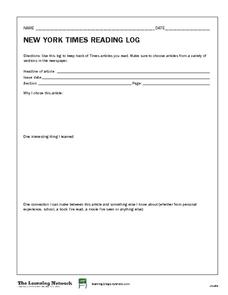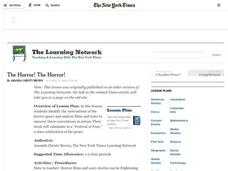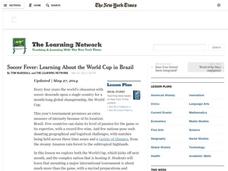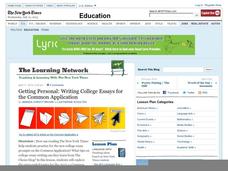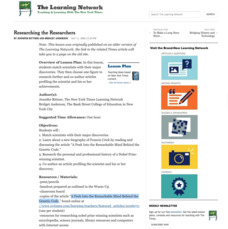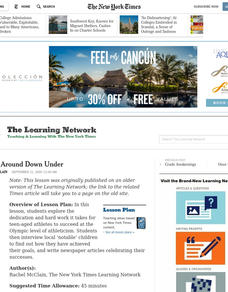The New York Times
New York Times Reading Log
Inspire your pupils to read the news and make connections between articles and another text, event, or experience with a straightforward reading log. Learners note down the article information at the top of the worksheet and then respond...
The New York Times
Sequencing the Stages: Understanding H.I.V. Infection at the Molecular Level
How does HIV operate at the molecular level? Pupils discover the progression from a healthy immune cell to one infected with HIV, watch an animation of the HIV life cycle, and finally identify each of the stages with illustrations...
The New York Times
The Careful Reader: Teaching Critical Reading Skills with the New York Times
The 11 lessons in this educators' guide focus on using newspapers to develop critical reading skills in the content areas.
The New York Times
The Horror! The Horror!
Gear up for Halloween by studying the horror genre with your class and analyzing films and texts to uncover the genre's traditional conventions.
The New York Times
Soccer Fever: Learning About the World Cup in Brazil
What an incredible collection of ideas for teaching about the 2014 World Cup in Brazil! This resource is packed with news articles and instructional activities on a wide variety of topics, from the global popularity of soccer and the...
The New York Times
Trouble in the Hive: Researching the Decimation of Honeybee Colonies
Teach your class about colony collapse disorder and foster discussion about causes and solutions for the honeybee problem. Class members read and discuss an article and participate in one of two detailed activities about pollination and...
The New York Times
Collateral Damage? Researching a Connection Between Video Games and Violence
Hook your class into an exploration of and discussion about violence in video games with a cute animal clip and a video game trailer. After a quick discussion about how media can affect mood, class members read a related article and...
The New York Times
Reader Idea | Thinking Like a Historian About Current World Events
Check out this fantastic research project where learners work to see the modern world through the eyes of a historian and analyze a contemporary event of their choice. An in-depth reflection on the project is given by the project...
The New York Times
Making Do: Learning and Growing Through Adversity
What is it that makes people keep going when they face challenges in life? Ask your class to consider this question in relation to their own experiences and as they read material from The New York Times. Using personal experiences...
The New York Times
News and News Analysis: Navigating Fact and Opinion in the Times
Help your class understand the difference between fact and opinion by exploring the New York Times homepage and articles. In pairs or small groups, pupils complete a scavenger hunt, answering the provided questions. Next, discuss the...
The New York Times
Decision Point: Understanding the U.S.’s Dilemma Over North Korea
Simulate the Situation Room and analyze the US's relationship with North Korea. The plan starts off with a quick review and an examination of a online timeline that updates as the situation continues. Next, the class reads an article and...
The New York Times
Understanding the Mathematics of the Fiscal Cliff
What exactly is the fiscal cliff? What are the effects of changing income tax rates and payroll tax rates? Your learners will begin by reading news articles and examining graphs illustrating the "Bush tax cuts" of 2001 and 2003. They...
The New York Times
Looking for Answers: Making Sense of the Boston Marathon Bombing
How should America respond to acts of domestic terrorism? What motivates or prompts a terrorist attack? After reading an opinion piece on the 2013 Boston Marathon bombing, your learners will critically analyze factors that could have...
The New York Times
Kiev in Chaos: Teaching About the Crisis in Ukraine
Provide a historical context for the political unrest between Russia and Ukraine that began in late 2013. Learners review their prior knowledge and chronicle new understandings with a KWL chart, watch a video explaining the Ukrainian...
The New York Times
Revolt! Comparing Historical Revolutions
What elements are needed to have a revolution? How do historical revolutions from across the globe and generations compare with one another? This is an excellent activity that incorporates group work, source analysis, and an engaging...
The New York Times
Should Anthony Weiner Resign?
The news regarding congressional representative Anthony D. Weiner's scandalous online communications was a hot-button topic in public media in 2011. Use this article to review the timeline of events surrounding the situation, and then...
The New York Times
Getting Personal: Writing College Essays for the Common Application
Develop an understanding of the open-ended questions that are a part of the college Common Application. Future college learners collaborate, discuss prompts acquired from the application, and philosophize on their plan of attack for the...
The New York Times
'The Century's Bitterest Journalistic Failure'? Considering Times Coverage of the Holocaust
Rich with primary sources and additional resources, this plan asks class members to think critically about newspaper coverage of the Holocaust. Focusing in particular on the analysis of the article "150th Anniversary: 1851-2001: Turning...
The New York Times
Laboratory Experiment
For any science class, learners can use this lab sheet to plan an experiment. It includes a space for the title, question, materials, setup, and procedure. If you want your class to complete this in typed form, you can provide the web...
The New York Times
The Cold War: Crossword
This crossword puzzle focuses on clues related to The Cold War. It also has unrelated clues that would be a challenge to middle schoolers, but should be manageable to secondary students; particularly juniors taking US history. There are...
The New York Times
Fill-In | Valentine's Day
Learners read an editorial on Valentine's Day and either fill in the blanks with their own words, or try to place the words from the word bank in the correct spots. This may be useful for English learners.
The New York Times
Researching the Researchers
Students match scientists with their major discoveries, choose one figure to research further, and co-author articles profiling the scientist and his or her achievements.
The New York Times
A Worker's Compensation
Middle schoolers read about the history of Labor Day in a newspaper article. They discuss difficulties American employees of the past had to face, learn about labor rallies, and conduct Internet research. Part of the intention of this...
The New York Times
Kidding Around Down Under
After reading an article, "From an Alternate to a 'Miracle Kid' in a Flash," youngsters discuss the kind of commitment required for a teenager to become an Olympic athlete. A variety of activities is suggested, and the popular topic...


